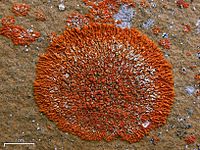
Photo from wikipedia
Microorganisms striving in extreme environments and exhibiting optimal growth and reproduction at low temperatures, otherwise known as psychrophilic microorganisms, are potential sources of cold-active enzymes. Owing to higher stability and… Click to show full abstract
Microorganisms striving in extreme environments and exhibiting optimal growth and reproduction at low temperatures, otherwise known as psychrophilic microorganisms, are potential sources of cold-active enzymes. Owing to higher stability and cold activity, these enzymes are gaining enormous attention in numerous industrial bioprocesses. Applications of several cold-active enzymes have been established in the food industry, e.g., β-galactosidase, pectinase, proteases, amylases, xylanases, pullulanases, lipases, and β-mannanases. The enzyme engineering approaches and the accumulating knowledge of protein structure and function have made it possible to improve the catalytic properties of interest and express the candidate enzyme in a heterologous host for a higher level of enzyme production. This review compiles the relevant and recent information on the potential uses of different cold-active enzymes in the food industry.
Journal Title: 3 Biotech
Year Published: 2021
Link to full text (if available)
Share on Social Media: Sign Up to like & get
recommendations!